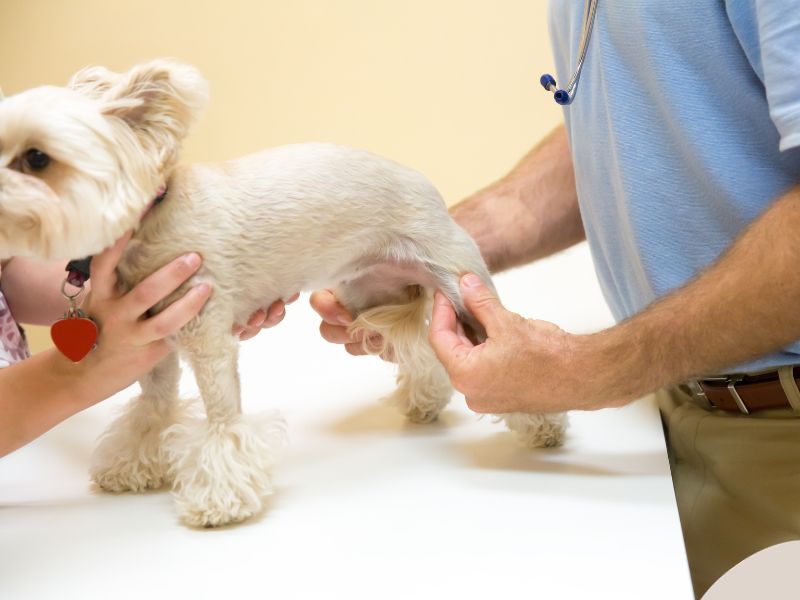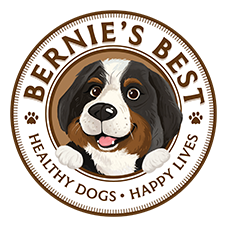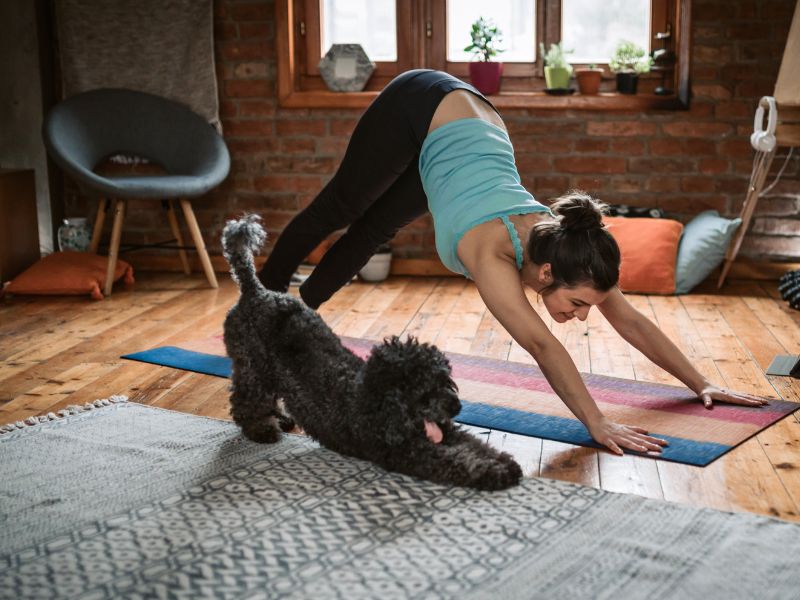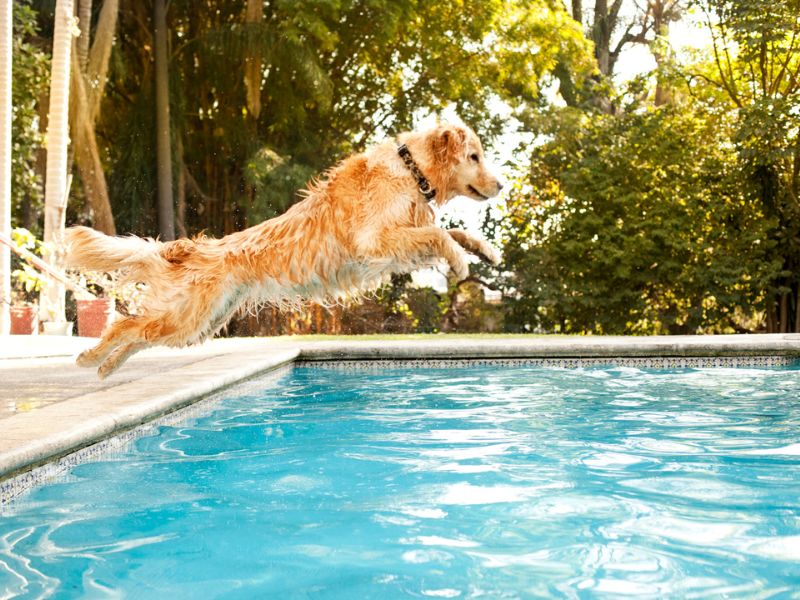We all know that our furry best friends love to run, jump, and play. But have you ever stopped to think about what makes all that movement possible? Or how you can help make that movement smooth and easy for your dog’s whole life? You might have guessed that it’s all about their joints! Like us, dogs have a complex joint system that allows them to move freely and enjoy life to the fullest. And just like us, there are things we can do to help our dogs have the best joint health they can!
Canine Joint Health: What’s It All About?
So, what exactly are dog joints? In simple terms, joints are the points where bones meet. They’re surrounded by soft tissue—ligaments, tendons, and cartilage—that provides cushioning and allows for smooth movement. Imagine them as the hinges on a door; without them, movement would be pretty tricky, and while you may be able to move the door, it could be tough.
The first thing to know about dog joints is that age affects them. Puppies, with their boundless energy and growing bodies, are still developing their joint systems. As they grow, their bones, muscles, and joints all work together in harmony. However, just like a new pair of shoes, they need to be “broken in” gradually to avoid injuries. If you’ve ever seen a puppy run at you full force and then end up with their heads over their bums because they couldn’t get their bodies to stop, you’ve likely seen what underdeveloped joints do.
On the other end of the spectrum, senior dogs have joints that have seen a lot of wear and tear. Over time, the natural cushioning in their joints can wear down, causing joint damage and leading to conditions like arthritis. It’s similar to how some humans have joint pain or develop stiffness as they age. Wear and tear indeed takes its toll.
Tips to Prevent Joint Pain in Dogs
The question many of us ask is what we can do to help prevent joint pain in dogs no matter their age? The good news is there are lots of different ideas we can share!
- Regular Exercise: Just like us humans, dogs need regular exercise to keep their muscles strong and joints flexible. However, it’s essential to ensure that the activity is age-appropriate. Puppies might benefit from short, frequent playtimes, while older dogs might enjoy longer, gentler walks. That’s often a tough thing to remember since it seems puppies have never-ending energy. While that may be true, their joints are definitely in the development stage, so shorter periods of play can give them the exercise they need as well as the rest of their developing bodies. Conversely, senior dogs who may even be suffering from joint disease or joint function issues may prefer a longer walk, provided that it’s gentle and they have the opportunity to go at their own pace. Either way, there’s merit to the adage, ‘If you want to keep moving, you keep moving,’ and regular exercise matters.
- Balanced Diet: Nutrition plays a significant role in joint health. Ensure your dog gets a balanced diet rich in Omega-3 fatty acids. Omega-3 fatty acids like those found in fish oil are the talk of the town when it comes to joint health in dogs, and for a good reason. These fats have been shown to reduce inflammation and support joint fluidity, ensuring smooth movement for your pup. They can also help reduce inflammation in the joints, so they’re good for dogs of all ages. When your dog is getting enough omega-3 fatty acids in a balanced diet full of bone-building ingredients, you know they’re going to feel their best!
- Watch Their Weight: Extra body weight can strain a dog’s joints. If your dog’s body weight puts too much strain, you may be allowing premature bone damage to happen. Ensure your dog maintains a healthy weight to minimize stress on their joints. Increased body weight is often the leading culprit behind degenerative joint disease, as well as other systemic conditions like diabetes and pancreatitis. Weight management is key when it comes to preventing joint issues in dogs and preserving healthy joints.
- Soft Landing Spots: If your dog loves to leap off couches or beds, consider getting ramps or soft landing mats to reduce the impact on their joints. This is especially important if you have solid, uncarpeted flooring. It may look comical as they jump and slide, but that can negatively impact their joints and lead to building damage they’ll pay for later.

- Regular Vet Check-ups: Regular vet visits can help catch potential joint issues early on. Your vet can recommend specific exercises or treatments based on your dog’s unique needs. Believe it or not, the way your dog walks and stands says a lot about their joint health, and your vet can give you information on everything from whether it feels like they have healthy cartilage, if they’re getting the proper nutrition, if their muscle mass is appropriate for proper joint development and more. They can even recommend physical therapy if they believe it would be beneficial for reducing joint pain or inflammation, and often done in combination with prescribing anti-inflammatory medications. Just as humans benefit from massages and physiotherapy, dogs can too! These therapies can help relax tight muscles and improve joint mobility, especially in senior dogs.
- Keep Them Hydrated: Water is crucial for joint health. It helps keep the joint cartilage hydrated and resistant to wear and tear. Ensure your pup always has access to fresh water, especially in their puppy and senior years.
- Avoid Repetitive Strain: Activities that involve the same movement over and over, like fetching a ball non-stop, can strain the joints. Mix up your dog’s play routines to give their joints a break. We know, we know… if Fido loves fetching his green frisbee until he drops, that can be hard to give up. Just remember that many dogs don’t have an ‘off’ button, and if you want to offer early intervention when it comes to preventing joint issues, you may have to put a cap on playtime. Low-impact exercise is really the best form, and if they do have an activity that involves repetitive movement, be sure to incorporate breaks.
‘Out-of-the-Box’ Tips to Improve Function and Help Slow Progression of Joint Deterioration
- Doggie Yoga: Just as yoga benefits humans by enhancing flexibility, balance, and strength, doggie yoga or “Doga” can offer similar advantages for your pup. It’s a fun way to bond and ensure your dog’s joints remain limber. It’s good for you and your dog!
- Pawdicure: Regularly checking and trimming your dog’s nails is crucial. Overgrown nails can cause an irregular gait, putting unnecessary strain on their joints. When your dog isn’t able to walk on all paw pads with the same weight distribution, they begin to accommodate for the off balance, and affected joints will start to be more problematic. This is often when vets see arthritis progression more quickly, and it’s sort of shocking how important keeping properly groomed nails can be.
- Hydrotherapy: Swimming or underwater treadmill sessions provide a low-impact exercise and strengthen muscles without putting stress on joints. It’s especially great for dogs recovering from surgery or injury, or if you just want to strengthen joints without worrying about harsh impact.
- Balanced Backpacks: Lots of dogs tackle the trails and byways with their pet parents. If you often take your dog on hikes, consider getting them a doggie backpack, but ensure the weight is evenly distributed on both sides. It can help build muscle, which supports joint health, as long as it’s not overloaded. Plus, they’ll feel good with a job and look adorable too.
- Puzzle Toys & Mental Games: While it may not seem directly related to joints, mental stimulation can prevent obesity by keeping your dog active. Obesity is a major factor in joint stress. Engage their minds and keep them moving!
- Ramps Everywhere: Consider installing ramps in places where your dog frequently jumps up or down, like the car or certain furniture. This can minimize the repetitive impact on their joints over time. That’s right– if they jump up on the bed every time you’re there, think about making it easier for them to get there without the jump to preserve joint function.
- Temperature Control: Cold weather can be tough on joints. Invest in heated dog beds or mats for those chilly nights, ensuring their joints remain warm and flexible.
- Alternative Therapies: Acupuncture and chiropractic care aren’t just for humans. They can be beneficial for dogs as well, especially if they have existing joint issues or as a preventive measure.
- Regular Stretching: Just as athletes stretch before activities, consider doing gentle stretches for your dog, especially if you’re about to engage in rigorous play. This can warm up their joints and muscles, reducing the risk of injury.
- Anti-Slip Mats: Slippery floors can be a nightmare for a dog’s joints, leading to unexpected sprains. Placing anti-slip mats around the house, especially in areas your dog frequents, can prevent these accidental slips.
- Massage: Gentle massage can stimulate blood flow to the joints, keeping them healthy. It also helps in identifying any unusual swelling or areas of concern early on.
- Custom Orthopedic Support: If your dog has a unique gait or posture, consider getting custom-made supports or orthopedic shoes. Yes, you read that correctly! They can correct and support their movement, reducing strain on the joints.
- Joint Supplements: These popular supplements are everywhere, it seems. Some of the most beneficial ingredients for canine joint health include glucosamine, chondroitin, and MSM but the truth is, new research is finding more efficacy with ingredients like green lipped mussel, turmeric, and Yucca Schidigera. These compounds can help repair damaged cartilage, reduce inflammation, and improve joint fluid, keeping those hinges well-oiled!
Can Joint Supplements Help Prevent Joint Pain and Issues In Dogs?
In a word, “Yes!” Research continues to find that natural, holistic ingredients in joint supplements for dogs may help prevent and repair joint damage. But not all are created equally, so what should you look for in a joint supplement? Many continue to use popular ingredients like glucosamine, chondroitin, and MSM. Still, the National Institute of Health suggests that results for those ingredients as preventative or pain medications simply aren’t consistent or conclusive.
What ingredients do show promise and efficacy, then? Several, actually, and even better, they’re cleaner and more natural. Some of our favorites are used in both our Marvelous Mobility and Healthy Hips supplements and include:
- Blueberry Powder & Green Tea Extract: When we talk about the health benefits of antioxidants, blueberry powder and decaffeinated green tea extract are stars of the show. They’re packed with compounds that help combat free radicals in the body. Free radicals can cause cellular damage and inflammation, potentially leading to joint issues. By neutralizing these free radicals, these ingredients help protect the joints and maintain their health.
- Turmeric & Boswellia: These are nature’s powerhouses for combating inflammation. Turmeric contains a compound called curcumin, which has been shown to reduce inflammation in the body. Boswellia, on the other hand, works by blocking the enzymes that create inflammation, making them an excellent combo for joint health.
- Yucca Schidigera & Black Pepper Extract: These two might sound exotic, but they’re potent allies for your dog’s joints. While Yucca Schidigera is known to reduce inflammation, black pepper extract enhances the absorption of other beneficial compounds, making your dog’s supplements even more effective.
- Astaxanthin: This super antioxidant is derived from microalgae and is known for reducing oxidative stress in the body. Oxidative stress can lead to inflammation and joint damage, so having Astaxanthin on board is a win for your pup’s joint health.
- Undenatured Type-II Collagen: Collagen is a key component of cartilage, and this particular type helps prevent autoimmune joint deterioration. By introducing undenatured type-II collagen to your dog’s diet, you’re directly supporting the health and structure of their joints.
- Flaxseed Oil & Anchovy Oil: We rave about Omega-3 fatty acids, and for a good reason. These fats have been shown to reduce inflammation and support joint fluidity, ensuring smooth movement for your pup.
- VermarisⓇ EPA + DHA, Algal Oil: Continuing the Omega-3 trend, these oils provide an additional source of these essential fatty acids. The more Omega-3s, the merrier the joints! The body can’t produce these Omega-3 fatty acids, so dietary supplements are key.
- Green-Lipped Mussel: This isn’t just a fancy mollusk from the shores of New Zealand. It’s packed with essential fatty acids, vitamins, and minerals, all of which play a role in maintaining joint health.
- Kelp Powder, Vitamin C, Boron, and vitamin K2: These ingredients are all about boosting bone density and supporting collagen synthesis. Healthy bones and cartilage are foundational to good joint health, making these ingredients essential for your dog’s well-being.
Our dogs bring so much joy to our lives. Their boundless energy, playful antics, and unconditional love are irreplaceable. At Bernie’s Best, we want dogs to live their healthiest, happiest lives. We believe that understanding the joint system and taking proactive steps to ensure our best friend’s joint health will allow us to give them long, active, and pain-free lives. Our goal isn’t just to add years, though; it’s to add life to their years, and preserving their joint health is just one of the many steps we can take to do so!



